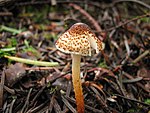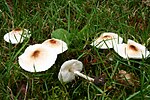
The Agaricales are an order of fungi in the division Basidiomycota. As originally conceived, the order contained all the agarics, but subsequent research has shown that not all agarics are closely related and some belong in other orders, such as the Russulales and Boletales. Conversely, DNA research has also shown that many non-agarics, including some of the clavarioid fungi and gasteroid fungi belong within the Agaricales. The order has 46 extant families, more than 400 genera, and over 25,000 described species, along with six extinct genera known only from the fossil record. Species in the Agaricales range from the familiar Agaricus bisporus and the deadly Amanita virosa to the coral-like Clavaria zollingeri and bracket-like Fistulina hepatica.

The Agaricaceae are a family of basidiomycete fungi and include the genus Agaricus, as well as basidiomycetes previously classified in the families Tulostomataceae, Lepiotaceae, and Lycoperdaceae.

Echinoderma is a genus of fungi in the family Agaricaceae. Its members were for a long time considered to belong to genus Lepiota and the group was then circumscribed by French mycologist Marcel Bon in 1981 as a subgenus of Cystolepiota before he raised it to generic status in 1991.

The Hygrophoraceae are a family of fungi in the order Agaricales. Originally conceived as containing white-spored, thick-gilled agarics, including Hygrophorus and Hygrocybe species, DNA evidence has extended the limits of the family, so it now contains not only agarics, but also basidiolichens and corticioid fungi. Species are thus diverse and are variously ectomycorrhizal, lichenized, associated with mosses, or saprotrophic. The family contains 34 genera and over 1000 species. None is of any great economic importance, though fruit bodies of some Hygrocybe and Hygrophorus species are considered edible and may be collected for sale in local markets.

Hygrophorus is a genus of agarics in the family Hygrophoraceae. Called "woodwaxes" in the UK or "waxy caps" in North America, basidiocarps are typically fleshy, often with slimy caps and lamellae that are broadly attached to decurrent. All species are ground-dwelling and ectomycorrhizal and are typically found in woodland. Around 100 species are recognized worldwide. Fruit bodies of several species are considered edible and are sometimes offered for sale in local markets.

Hygrocybe is a genus of agarics in the family Hygrophoraceae. Called waxcaps in English, basidiocarps are often brightly coloured and have dry to waxy caps, white spores, and smooth, ringless stems. In Europe they are characteristic of old, unimproved grasslands which are a declining habitat, making many Hygrocybe species of conservation concern. Four of these waxcap-grassland species, Hygrocybe citrinovirens, H. punicea, H. spadicea, and H. splendidissima, are assessed as globally "vulnerable" on the IUCN Red List of Threatened Species. Elsewhere waxcaps are more typically found in woodlands. Most are ground-dwelling and all are believed to be biotrophs. Around 150 species are recognized worldwide. Fruit bodies of several Hygrocybe species are considered edible and are sometimes offered for sale in local markets.
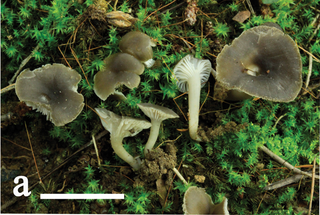
Camarophyllopsis is a genus of agarics in the family Clavariaceae. Basidiocarps are dull-coloured and have dry caps, rather distant, decurrent lamellae, white spores, and smooth, ringless stems. In Europe species are characteristic of old, unimproved grasslands which are a declining habitat, making them of conservation concern.

Entoloma is a genus of fungi in the order Agaricales. Called pinkgills in English, basidiocarps are typically agaricoid, though a minority are gasteroid. All have salmon-pink basidiospores which colour the gills at maturity and are angular (polyhedral) under a microscope. The genus is large, with almost 2000 species worldwide. Most species are saprotrophic, but some are ectomycorrhizal, and a few are parasitic on other fungi. The type, Entoloma sinuatum, is one of several Entoloma species that are poisonous, typically causing mild to severe gastrointestinal illness.

Macrolepiota is a genus of white spored, gilled mushrooms of the family Agaricaceae. The best-known member is the parasol mushroom (M. procera). The widespread genus contains about 40 species.

Lepiota brunneoincarnata, the deadly dapperling, is a gilled mushroom of the genus Lepiota in the order Agaricales. Widely distributed in Europe and temperate regions of Asia as far east as China, it grows in grassy areas such as fields, parks and gardens, and is often mistaken for edible mushrooms. The mushroom has a brown scaled cap up to 4 cm wide with a pinkish brown stem and white gills. It is highly toxic, with several deaths having been recorded as it resembles the edible grey knight and fairy ring champignon.

Melanoleuca is a poorly known genus of saprotrophic mushrooms traditionally classified in the family Tricholomataceae. Most are small to medium sized, white, brown, ocher or gray with a cylindrical to subcylindrical stipe and white to pale yellowish gills. The basidiospores are ellipsoid and ornamented with amyloid warts. Melanoleuca is considered a difficult group to study due to their macroscopic similarities among species and the need of a thorough microscopic analysis to separate species. DNA studies have determined that this genus is closely related to Amanita and Pluteus and that it does not belong to the family Tricholomataceae.
Endoptychum is a genus of secotioid fungi in the family Agaricaceae. Like the majority of secotioid taxa, the individual species of Endoptychum are thought to be recent mutations from agaricoid species, hence, Endoptychum is likely not a valid monophyletic genus.

Leucoagaricus is a genus of mushroom-forming fungi in the family Agaricaceae. As of March 2023 there are over 200 accepted species of Leucoagaricus with ongoing research into the genus adding several more each year. Leucocoprinus is a similar genus and considered by some sources to be indistinct from Leucoagaricus based on genetic data that demonstrates they are monophyletic. Species are separated into these genera based on macroscopic features such as cap striations in Leucocoprinus or the more persistent basidiocarps (mushrooms) of Leucoagaricus as well as microscopic features such as the lack of a germ pore in Leucoagaricus species. As a result of the similarities and disagreement on taxonomy, many of the species within these genera have formerly been classified in the other and may still be known by previous classifications. For instance the species Leucoagaricus gongylophorus is cultivated by fungus-growing ants but was formerly known as Leucocoprinus gongylophorus whilst other species cultivated by the lesser attine ants are still classified as undescribed Leucocoprinus species.
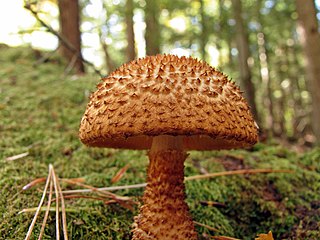
Leucopholiota decorosa is a species of fungus in the mushroom family Tricholomataceae. Commonly known as the decorated pholiota, it is distinguished by its fruit body which is covered with pointed brown, curved scales on the cap and stem, and by its white gills. Found in the eastern United States, France, and Pakistan, it is saprobic, growing on the decaying wood of hardwood trees. L. decorosa was first described by American mycologist Charles Horton Peck as Agaricus decorosus in 1873, and the species has been transferred to several genera in its history, including Tricholoma, Tricholomopsis, Armillaria, and Floccularia. Three American mycologists considered the species unique enough to warrant its own genus, and transferred it into the new genus Leucopholiota in a 1996 publication. Lookalike species with similar colors and scaly fruit bodies include Pholiota squarrosoides, Phaeomarasmius erinaceellus, and Leucopholiota lignicola. L. decorosa is considered an edible mushroom.
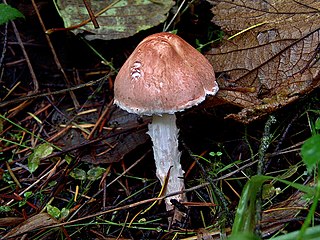
Lepiota subincarnata, commonly known as the fatal dapperling and deadly parasol, is a gilled mushroom of the genus Lepiota in the order Agaricales. It is known to contain amatoxins and consuming this fungus can be potentially lethal. The species is found in Asia, Europe, and North America, in woods as well as richly soiled parks. It was first described scientifically by the Danish mycologist Jakob Emanuel Lange in 1940. Bon and Boiffard described Lepiota josserandii in 1974, which turned out to be the same species.
Lepiota viridigleba is a species of sequestrate fungus in the family Agaricaceae. It was first described as new to science by mycologist Michael Castellano in 1995, based on collections made among Populus roots in California. The fungus was initially called Amogaster viridiglebus and tentatively placed in the order Boletales. Molecular analysis revealed the fungus to be a member of the genus Lepiota, and it was transferred to that genus in 2013.

Lepiota castaneidisca is a species of agaric fungus in the family Agaricaceae. Formally described in 1912, it was for a long time considered the same species as the similar Lepiota cristata until molecular analysis reported in 2001 demonstrated that it was genetically distinct. It is most common in coastal and northern California, and has also been recorded in Mexico. A saprobic species, it is usually found under redwood and Monterey cypress. Its fruit bodies (mushrooms) have white caps with an orange-red to orange-brown center that measure up to 3.2 cm (1.3 in) wide. The cream-colored to light pink stems are up to 6.5 cm (2.6 in) long by 0.2–0.6 cm (0.1–0.2 in) thick, and have a ring. L. castaneidisca can be distinguished from other similar Lepiota species by differences in habitat, macroscopic, or microscopic characteristics.

Lepiota cristata, commonly known as the stinking dapperling, brown-eyed parasol, or the stinking parasol, is an agaric and possibly poisonous mushroom in the family Agaricaceae. A common and widespread species—one of the most widespread fungi in the genus Lepiota—it has been reported from Europe, northern Asia, North America, and New Zealand. It fruits on the ground in disturbed areas, such as lawns, path and road edges, parks, and gardens. The species produces fruit bodies characterized by the flat, reddish-brown concentric scales on the caps, and an unpleasant odour resembling burnt rubber. Similar Lepiota species can sometimes be distinguished from L. cristata by differences in cap colour, stipe structure, or odour, although some species can only be reliably distinguished through the use of microscopy.



